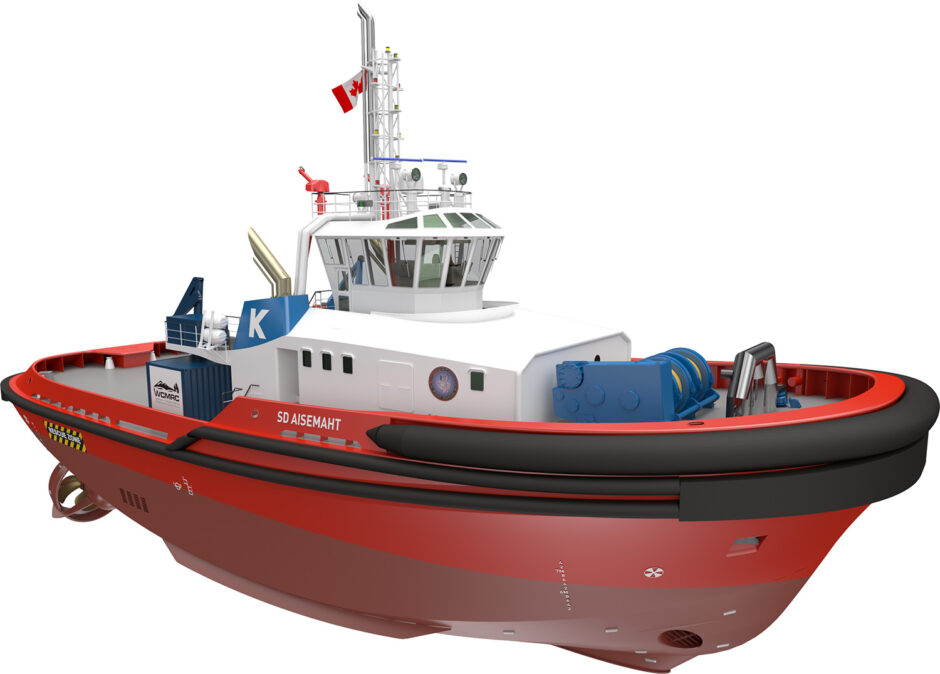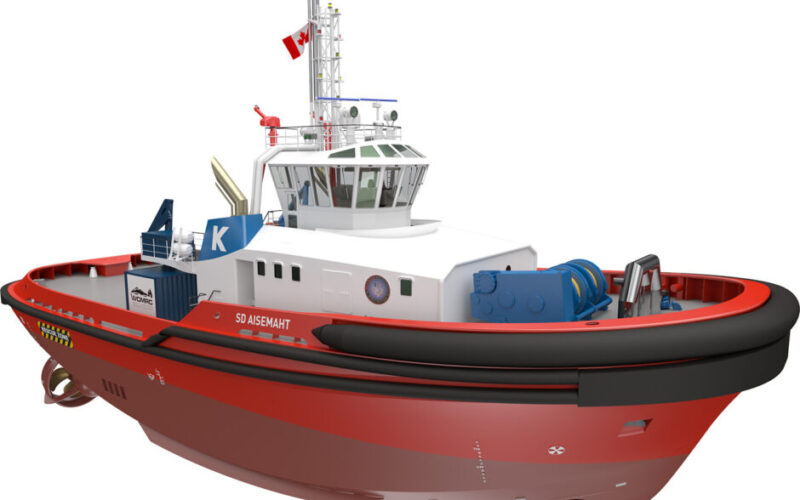(VANCOUVER, British Columbia) — KOTUG Canada has selected Turkey’s Sanmar Shipyards to build two RAsalvor 4400-DFM dual-fuel methanol escort tugs, designed by Robert Allan Ltd. (RAL), to service the Trans Mountain Expansion Project (TMEP).
These tugs will escort tankers from the harbor limits of the Port of Vancouver to the open Pacific Ocean through the commercial shipping lanes of the Salish Sea. To provide this service, KOTUG Canada has partnered with Sc’ianew First Nation from Beecher Bay, which is strategically located along the shipping route.

The tugs, to be named SD Aisemaht and SD Qwii-Aan’c Sarah in honor of the Sc’ianew First Nation, are scheduled to be the world’s first large purpose-built high bollard pull methanol-fueled tugs when they enter service in 2025. They will provide significant environmental benefits to further reduce greenhouse gas (GHG) emissions and underwater radiated noise.
The relationship between Vancouver-based Robert Allan Ltd. and KOTUG dates back many years, with KOTUG operating over a dozen Robert Allan Ltd. designed high bollard pull harbor and offshore ASD and Advanced Rotortug (ART) vessels internationally.
The RAsalvor 4400-DFM tugs will measure 144 feet in length and are an evolution of Robert Allan Ltd.’s escort tugs, which operate in some of the harshest environments in the world. With over 115 tonnes of bollard pull, they’ll be Canada’s most powerful escort tugs.
Both vessels will be equipped with a mechanical cross link system between the azimuth thrusters to enable a single engine to drive both propellers. They will also be equipped with main engine driven shaft generators to satisfy the vessel’s normal electrical needs. These features will allow the crews to optimize engine loading and significantly reduce fuel consumption and running hours of the main engines and gensets.
Combined, these features will reduce the tugs underwater radiated noise, mitigating the effects of shipping on the Salish Sea’s southern resident killer whales. Additionally, KOTUG is having the hulls of both tugs coated with a graphene paint to reduce biofouling and enhance hull-smoothness which reduces underwater radiated noise and makes the vessels more fuel efficient.
The escort tugs are equipped with firefighting equipment meeting the requirements of the American Bureau of Shipping (ABS) FFV 1 notation and will have the largest spill response capabilities of any tugs on the British Columbia coast to mitigate the risk of marine spills to the Salish Sea and communities from laden tankers as well as other commercial marine traffic.
Onboard equipment will include heavy duty electric winches fit fore and aft for reduced noise and to significantly reduce the risk of a hydraulic oil spill into the environment. The forward escort system has been customized to suit the requirements of the local pilots for tankers utilizing the TMEP. The aft towing system, with a dual drum winch with more than 6,500 feet of steel wire, is among the largest fit to an escort tug. Combined with the vessel’s maneuverability, it provides the capability to perform emergency towage of vessels along the route that may find themselves in distress.
Inside, the accommodation space will include dedicated cabins and ensuites for all regular crew, all with natural light and well in excess of regulatory standards. To facilitate training and additional response capability, extra berths will be provided for use by Western Canada Marine Response Corp. (WCMRC) spill response technicians.
Particular attention has been paid to minimize noise and vibration aboard the vessels, with a crew comfort (habitability) class notation to be assigned by ABS along with ENVIRO and SUSTAIN notations demonstrating the projects reduced environmental impact.
– Robert Allan Ltd.

